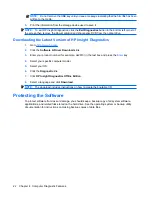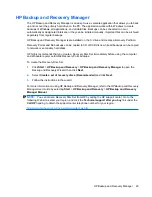
Attachment (SATA), and serial attached SCSI (SAS) disk drives that are attached to Smart Array
controllers and select MSA controllers configured as part of a logical volume. To determine the health
of a hard disk drive, Diagnosis looks at operational history provided by the hard disk drive and proprietary
information provided by the Smart Array controller or the MSA controller. HP has found through
experience that looking at operational history is one of the best ways to diagnose disk drive problems.
Systems Insight Manager (SIM) and Diagnosis are now the only tools that can be used to qualify the
replacement of defective disk drives under pre-failure warranty.
The Smart Array Drive Diagnosis feature should be used:
●
To determine if a disk drive in a fault mode should be replaced.
●
When Systems Insight Manager reports that a disk drive has failed.
●
When there is data corruption or storage related problems but there are no error LEDs or error
messages.
●
When there are inconsistent, intermittent, or repeated disk drive failures.
●
To determine the health of a logical volume.
NOTE:
Smart Array Drive Diagnosis has the unique capability of identifying multiple disk drives in a
single volume that are functioning normally, but should be replaced.
To diagnose a logical volume:
1.
Click the
Diagnose
tab.
2.
Under
Smart Array Drive Diagnosis
, click
+
to expand Storage.
3.
Select the logical volumes to diagnose and click the
Diagnose
button.
4.
The test status of the logical volumes selected will be displayed on the
Status
tab when Diagnosis
has completed.
Test Tab
The Test tab allows you to choose various parts of the system to test. You can also choose the type of
test and testing mode.
There are three types of tests to choose from:
●
Quick Test
—Provides a predetermined script where a sample of each hardware component is
exercised and requires no user intervention in either Unattended or Interactive mode.
●
Complete Test
—Provides a predetermined script where each hardware component is fully tested.
There are more tests available in the Interactive mode, but these require user intervention.
●
Custom Test
—Provides the most flexibility in controlling the testing of a system. The Custom Test
mode allows you to specifically select which devices, tests, and test parameters are run.
HP Insight Diagnostics
19
















































